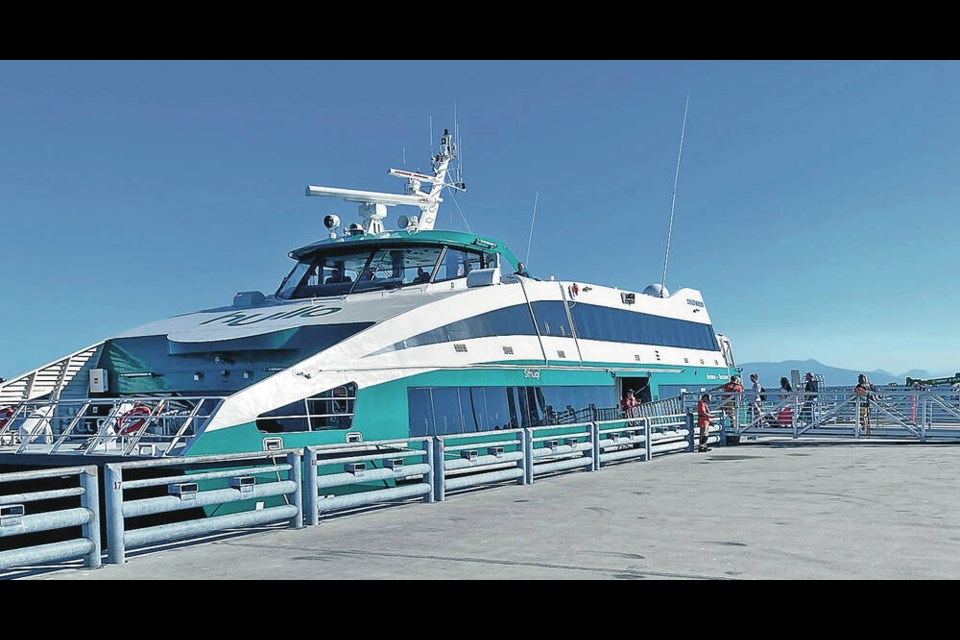It’s my belief, privately held until now, that whiny online posts about travel woes are the most boring thing in the entire social media universe.
Your baggage got misplaced. Your flight was delayed.
What am I supposed to do with that information?
Who do you think cares?
So the new Hullo ferry’s abruptly postponed launch, its communication falldowns, the ignored emails, are my problem, not yours. Besides, the issues are common to the whole travel industry. It’s not news, it’s the norm.
It’s the overall trip that counts, not the details. From that perspective, Hullo’s launch on Wednesday was an interesting, enjoyable experience that felt like a glimpse into the future.
A Nanaimo-Vancouver trip (Nan to Van, they’re calling it) took from 10:05 a.m. to 11:20 a.m. and ran smoothly throughout. The Sthuqi’, one of two 42-metre high-speed passenger-only catamarans, cast off from its new Nanaimo terminal, cruised briskly around Gabriola Island and then throttled up.
It hit 40 knots (75 km/h) in no time in a light chop and not a drink was spilled. It’s a few klicks faster than the Victoria Clipper to Seattle.
Seating is equivalent to the three airline classes and they come with seatbelts, which are optional and went mostly unused.
With water spraying on the windows, it felt like an extended-play Harbour Air landing.
The Vancouver skyline appeared inside of 40 minutes and the ferry cruised under Lion’s Gate Bridge by the 60-minute mark. People started walking up the ramp to Canada Place at about 11:25 a.m. For mid-Islanders accustomed to an hour-and-a-half-long sail to Horseshoe Bay or Tsawasssen (not counting the lineup), then an hour-long grind through gridlock to downtown Vancouver, it’s an attractive proposition.
The boomerang return trip was equally enjoyable. Watching the entrance to Horseshoe Bay fly by made the thought of Upper Levels bumper-to-bumper traffic a distant memory.
One Island couple boarded with understandable grudges about being left in the dark on Monday, when they had to drive all the way to the terminal to find out the sailings had been cancelled. They were also curious, verging on skeptical, about how it will handle November to February waters, which aren’t nearly as perfect as Wednesday’s.
Hullo staff said a loose guideline is that their weather cancellation thresholds will be about the same as B.C. Ferries.
There were a few comparisons in passenger chatter to B.C. Ferries and Hullo won most of them.
The venture carries a lot of baggage when it comes to coastal residents’ institutional memory. B.C.’s fast-ferry history is a story of failures that go back 50 years. The Salish Sea is the graveyard of the Pacific for fast ferries.
A “Pacific Hovercraft” started in 1969 featuring stewardesses in miniskirts and go-go boots. It ceased on a permitting issue and went bankrupt in a few months. A Norwegian outfit started Royal Sealink Express 21 years later. It collided with a B.C. Ferries vessel right out of the gate and gave up in 10 months.
Ten years later, local investors gave it a try, but an engine failure turned into a financial disaster.
Space prohibits a full account of the NDP government’s fast-ferry attempt in the mid-1990s, which was a financial and political disaster.
A deep-pocketed Australian outfit tried again in 2017 with a downtown Victoria to downtown Vancouver run. A $2-million mechanical failure sidelined the vessel early on and they never recovered. The route was so long it negated the speed advantage and the vessels were notable for the near-complete absence of passengers, who balked at the $150 price point. They gave up in 2020. (Hullo is currently charging $40 to $60, depending on seat class.)
So the skepticism about Hullo’s future is entirely warranted.
But it’s operating in a different seascape now.
Gas is almost $2 a litre. Metro Vancouver’s transit system is steadily improving. It costs up to $83 to drive onto a conventional ferry, and that fare is going nowhere but up.
Also, B.C. Ferries has lost its mojo. Pandemic side-effects and the NDP government’s ineffectual meddling have thrown the outfit for losses that will take years to overcome.
If privately owned Hullo has enough cash to weather start-up hiccups, catches a few breaks and can conquer the staff recruitment problem common to all carriers, it could make a go of it. Based on Wednesday’s performance, it has potential.
>>> To comment on this article, write a letter to the editor: [email protected]


